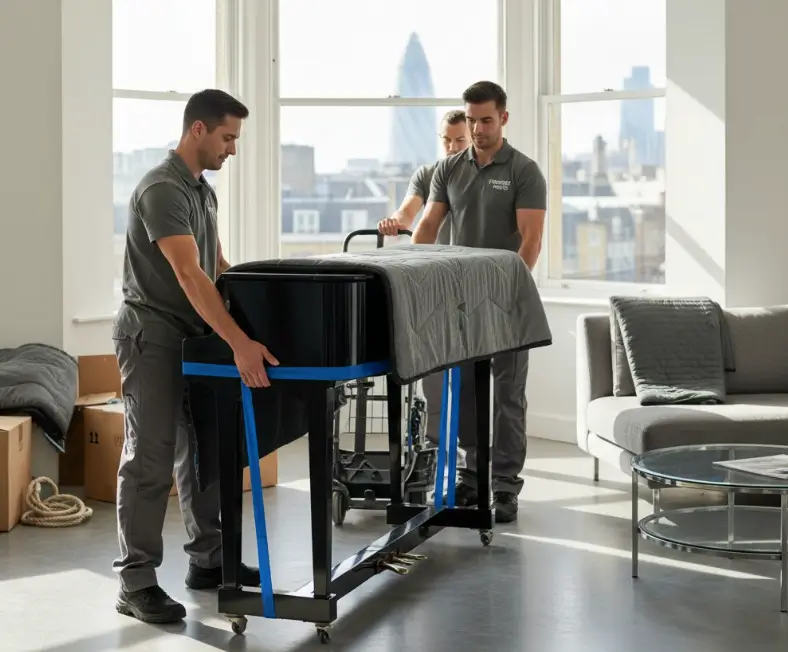Learn how to measure for a piano move safely and accurately. Follow our expert guide to prepare doorways, stairs, and halls for piano moving in London, UK.
Moving a piano isn’t like moving any other piece of furniture — it’s a delicate balance of precision, planning, and protection. Before your piano movers arrive, the most important step you can take is to measure for a piano move properly. This ensures your piano fits safely through every doorway, hallway, and stairway during the move.
At Piano Logistics Transport, we’ve handled hundreds of piano moves across London and throughout the UK, and one of the most common causes of moving delays or damage is improper measurement. In this guide, we’ll show you exactly how to measure your space to make your piano move smooth and stress-free.
Why It’s Important to Measure for a Piano Move
Before lifting a single note, you need to ensure that your piano can pass through every part of your property — from the room it’s in to the moving truck outside.
Taking time to measure for a piano move helps you:
- Prevent damage to the piano and property
- Avoid extra costs from failed or delayed moves
- Help movers plan the safest route in advance
- Save time during moving day
Whether you’re moving an upright, baby grand, or concert grand piano, correct measurements are the first step toward a successful relocation.
Understanding Piano Sizes and Dimensions
Different types of pianos require different moving strategies. When you measure for a piano move, start by knowing your piano’s dimensions:
| Type | Average Width | Average Height | Average Length |
|---|---|---|---|
| Upright Piano | 58–60 inches | 48–60 inches | 24 inches |
| Baby Grand | 55 inches | 36 inches | 60–70 inches |
| Concert Grand | 60 inches | 40 inches | 84–108 inches |
Record these dimensions carefully before comparing them with your doorway and hallway measurements.
Step-by-Step: How to Measure Doorways for a Piano Move
When you measure for a piano move, always begin with doorways — they’re the most common obstacle. Here’s how to do it right:
1. Measure the Width of the Doorway
Open the door fully and measure from frame to frame, not the door itself. Include any molding or trim that might reduce space.
2. Measure the Height
Next, measure from the floor to the top of the doorway. This helps determine if a tall upright piano will fit without tipping.
3. Check Door Swing and Handle Space
See whether the door opens inward or outward. Sometimes, removing the door from its hinges adds an extra inch or two — which can make all the difference.
4. Measure for Obstacles Around the Door
Look for radiators, corners, or stairs near the doorway that might make turning difficult. Always include this in your notes.
How to Measure Hallways and Stairways for a Piano Move
Once the doorways are clear, it’s time to measure for a piano move through hallways and staircases.
1. Measure Hallway Width and Height
Measure the narrowest point along the hallway — especially where walls curve or protrude.
If your hallway includes turns, measure corner-to-corner space to ensure movers can rotate the piano safely.
2. Measure Stair Width and Landing Area
For stairways, measure both the width of the stairs and the size of the landings. If the piano must turn mid-staircase, movers need to know if there’s enough space.
3. Note Ceiling Height on Stairs
Low ceilings above staircases are often overlooked when people measure for a piano move. Make sure your movers know the exact clearance height.
Tools You’ll Need to Measure for a Piano Move
You don’t need fancy equipment — just accuracy. Gather these tools:
- Measuring tape (at least 5 meters)
- Notebook or phone to record measurements
- A friend to help with long measurements
- Masking tape (optional, to mark clearance points)

Common Mistakes to Avoid When Measuring
When you measure for a piano move, small errors can cause big problems. Avoid these common mistakes:
- Forgetting to measure stair landings or hall corners
- Estimating instead of using a tape measure
- Ignoring door handles and trim
- Not considering the piano’s stand or lid
- Measuring only one route instead of multiple options
Professional movers like Piano Logistics Transport always double-check these details before move day.
Why Choose Professional Piano Movers in London
Even if you measure everything perfectly, piano moving still requires expertise. Our team at Piano Logistics Transport provides:
- Specialized piano moving equipment
- Experienced and insured movers
- Protective wrapping and crating
- Flexible scheduling across London and the UK
We make sure your piano arrives in tune, on time, and without a scratch.
📞 Call us at 0207 965 7363 or email piano.logistics.transport@gmail.com for a free quote.
Extra Tips for a Smooth Piano Move
- Clear all pathways before movers arrive.
- Protect floors with blankets or mats.
- Remove decorative items from walls and hallways.
- Label doors and routes for movers.
- Take photos before and after the move for records.
Conclusion / Final Words
Taking the time to properly measure for a piano move is one of the smartest steps you can take to ensure a safe, smooth relocation. Whether you’re moving within London or across the UK, accuracy in your measurements helps both you and your movers plan every detail with confidence.
For professional help, contact Piano Logistics Transport — your trusted piano moving experts in London.
Follow us on Facebook: https://web.facebook.com/profile.php?id=61568731813940
🌐 https://piano-logistics-transport.co.uk
📧 piano.logistics.transport@gmail.com
📍 International House, 12 Constance Street, London E16 2DQ
📞 0207 965 7363
Frequently Asked Questions (FAQ)
1. How do I know if my piano will fit through my door?
Measure the doorway width and height, then compare it with your piano’s dimensions. If it’s close, professional movers can help with safe angle entry.
2. Can I remove doors to make more space?
Yes, removing a door from its hinges can add 1–2 inches, which often helps during a piano move.
3. What if my hallway is too narrow?
Movers can use lifting straps or disassemble minor parts of your piano to fit through tight spaces.
4. Do I need to measure stairs separately?
Absolutely. Staircases, especially with turns, must be measured for width, height, and landing space.
5. Should I hire movers even if my piano fits easily?
Yes — pianos are heavy and delicate. Professional movers ensure safety and avoid injuries.
6. How far in advance should I book a piano move in London?
Ideally, book 1–2 weeks in advance, especially during weekends or holidays.
7. Can I move a piano without special tools?
It’s not recommended. Professionals use trolleys, straps, and padding to protect both your piano and property.
8. What’s the average cost of a piano move in the UK?
Costs vary by distance, size, and accessibility. Contact us for a free quote.
9. How long does it take to move a piano in London?
Most local piano moves take 1–3 hours, depending on location and setup.
10. Do you offer long-distance piano transport in the UK?
Yes, we cover all major UK cities from London, offering insured and secure piano moving services.




